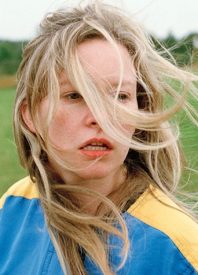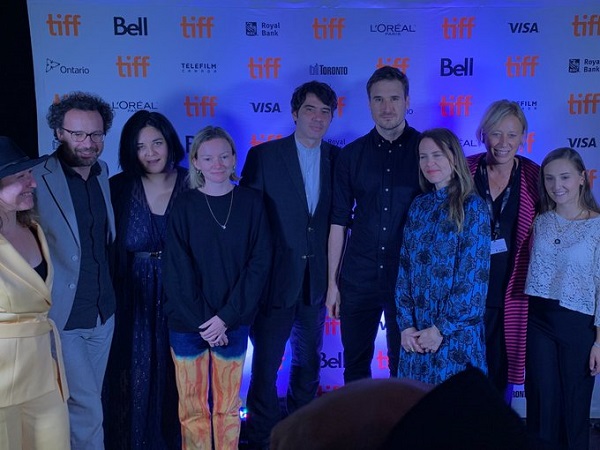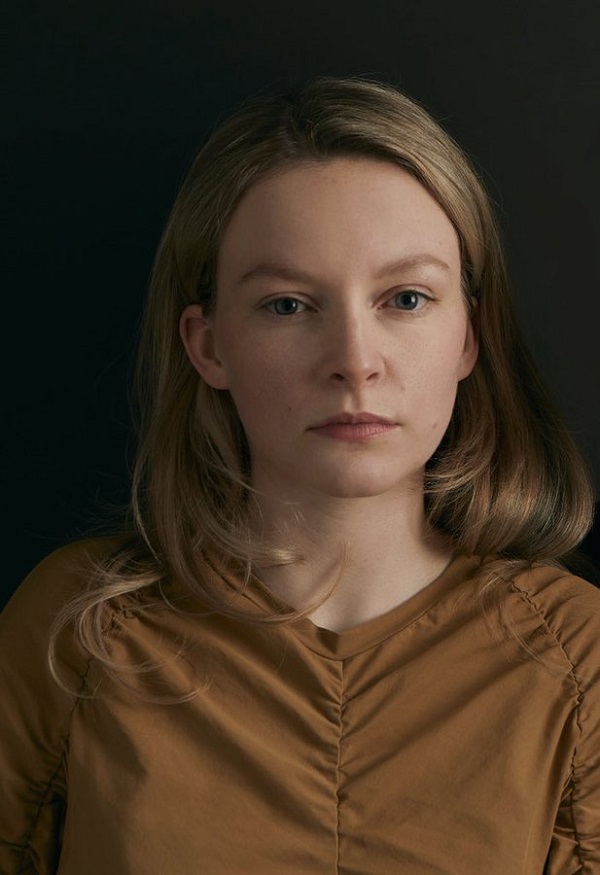
Thomas: What was the inspiration for Anne at 13,000 Ft.
Kazik: All my films come from a personal place. Tower, How Heavy This Hammer, they’re all kind of in dialogue with each other.
More practically speaking, I wrote this for Deragh. I wanted to work with Deragh. So that was definitely an inspiration. There’s now a wave of Toronto filmmakers, and so getting the opportunities to work with people on the same level as you is a new thing.
Autobiographically, at the daycare itself where we filmed my Mum has worked there for forty years. I went there as a child. A small epiphany was going back there as an adult and seeing all these women who worked there and looked after me as a child, getting to meet me as an adult.
Did they remember you?
Oh yeah, of course. It’s my Mum in the film, she plays the supervisor in two or three scenes.
Suzanne is the name of the daycare worker that Anne comes into conflict with. Does that come from stories your Mom had?
The coffee cup story…there’s actually a more intense version of that story.
That felt so real to me as someone who has worked summer camps and whatnot before.
It’s definitely a part of those interpersonal dynamics. I had a lot of conversations with my Mother during the shooting process. Suzanne is an actress, but a lot of the supporting daycare workers actually work there. That’s how my Mum ended up acting in the film. She just ran one of her meetings and we filmed. We would learn more and more about the dynamics, and then we would build off them. The conflicts developed more and got more specific as we researched.
Another dynamic with the daycare is working with the children. Half of them are actors. The other half the time, we’d sign permission forms and Deragh would go into the classroom. We would follow her around and improvise small moments. The opening of the film is a good example of that. Something happens and we turn it into a scene.
What were some of the lessons you took from your other two features that you applied to Anne.
It’s hard to say, because there is so much. On every level it’s a slight evolution; even the editing! I’ve worked with Ajla (Odobasic) on all of my films, and the nature of the cutting (in Anne) is, I think, us honing in a particular style. The opening juxtaposition, for example, wasn’t written but it came out of Ajla and I working together.
We planned more for this film. Deragh and I wrote so much backstory for this character, and then it became a process of stripping that away. We screened the film for a lot of health care professionals, and their take reinforced our view that less is more, that it’s more interesting if we don’t know. There’s a danger of over planning. You can kill it by over planning and overthinking. We just started cutting it out. It’s truer to life, and ended up reminding me of my other films. Something is happening, but we don’t know exactly what. It’s this feeling of being very close to someone, but it’s very mysterious. I think that’s true to life.
Deragh is incredible in this film. What was the collaborative process with her like?
Deragh and I are friends, obviously, and that was a big part of it. She brings a level of nuance to performance. She can do anything. My other films I had to rely on it being loaded, or well written enough that it would function with actors. With Deragh she can make a lot of stuff work, which is a blessing and a curse.
You feel like you can do anything then?
Exactly! Which is great if you can harness it, but it can be difficult to make decisions. Working with her and really trusting her instincts helped. If something wasn’t working, or if she was hesitating, I would take note of that and recalibrate it. At the same time, she has such a confidence and bravery as an actress. Not just in jumping out of a plane, but in the emotional range she brings and how big she can go. There were a couple of moments that I thought would be a small scene, and it just exploded and I would try and go with her.
Her performance reminds me of Gina Rowlands in Cassavetes work. Is that an influence for you?
I mean of course. Cassavetes, but also for a Canadian influence Allan King. Maybe Mike Leigh too. That’s what I learned about film school in my undergrad, about Canadian documentary and American Independent Cinema.
There are tons of influences though. I mean, I was a cinephile before I was a filmmaker. Even just something like Passion of Joan of Arc is deeply ingrained in me. That came out early in my work with Princess Margaret Blvd. So, while in some ways this is an evolution from the last two features, it’s weirdly sometimes it’s a return to core influences. The skydiving, for example, when I was an undergrad Mister Lonely came out and that was the return of Harmony Korine. There’s that skydiving scene in Mister Lonely, and I think that’s him referencing Leos Carax’s Mauvis Sang, which (also) has skydiving. Sometimes people will ask why skydiving? And I think that’s part of it.
Everyone is saying Cassavetes, and I guess it’s true. I’ve always wanted to have a great female performance, but also, just the way that Cassavetes uses his life. Using my mother in the film is very Cassavetes. My Mom’s very difference from Cassavetes, but if you’re doing him the right way it’s very hard to copy him because life is so complex. At the same time, taking influence from Cassavetes is like taking influence from Shakespeare. It’s the fabric of cinema.
Let’s talk about the Skydiving. How did you guys shoot that?
That was the first scene we shot. Deragh jumped out of the plane in the first scene we did. One of the surprising things is that it was very doable. I’d like to say that it was this very complex scene, but you know, people go skydiving all the time. We had a lot of control over it.
The main thing was Deragh jumping out of a plane. (Cinematographer) Nikolay (Michaylov) and I looked at the footage, however, and it wasn’t quite right. The bigger challenge was getting Deragh to jump out of a plane again. How we approached that was I became the stand in. I’ve never jumped out of a plane before either. We did a camera test on me and showed that to Deragh, and were like “see that looks better.”
Every skydiver is a filmmaker. They all use GoPros. That’s how they share skydiving. It was so much fun to collaborate with them. And a lot of the skydivers acted in the film.
What was it like jumping out of the plane?
I wish I could say “it’s the thrill of my life,” or “it’s terrifying,” but I think that I made myself so preoccupied with the camera that I wasn’t really present. I remember hanging in mid-air and the guy strapped to my back is like: “c’mon man, this should be more thrilling. Stop talking about the camera!”
Anne’s relationship with her mother is another peculiar part of the film. What inspired that relationship?
I feel like this is a theme present in my other films too. the main character is alienated, but there aren’t overt antagonists. Everybody is doing their best. It’s the predicament of the mother, who is trying to do everything possible. It stands in for the viewer: “how do we help this person, what is appropriate.”
The mother is a bit of a safety net. While there are dangers for Anne, ultimately, there is this safety net. It focuses a little bit more on the internal lives, and not just an externally explainable tension.
One of the incredible things about the film is that you can see a lot of yourself in Anne and also the people that surround Anne. You really understand where both sides are coming from.
Obviously, if someone says it’s a really subjective thing and they got in Anne’s head, I’m not going to argue. But I view the film somewhat objectively. The handheld camerawork is kind of personal, kind of intimate, but at the same time it’s handheld. It’s shown as someone reacting to it, and the camera is also an actor.
You are known for making these relatively low-budget films, and you run an independent film collective here in Toronto. What are some pieces of advice that you would give to a filmmaker looking to make their cheap first feature?
Money is relative. You can have a million dollars, but if you have to hire thirty to forty people it disappears very quickly. I get that my films are always framed as being low-budget films, but me having 200,000 and being able to spend it as I see fit is a real privilege. Even though we’re working with a relatively little amount of money, I often think that my crew is better taken care of than on a larger shoot.
This is what I would say to a young film student, especially if you’re working low-budget—make sure everybody on set is contributing artistically. I keep mentioning Nikolay, Ajla, (producer) Dan (Montgomery), but it’s their film too and they’re engaged. They’re not hired guns. Money disappears quick if you’re just hiring someone to come in.
Practical set-backs quickly become advantages. One example would be that we would have to schedule shoots around people’s day jobs. So they were often short shoots, and so we could only shoot one scene as a time, which was a huge advantage in that we didn’t have to shoot ten scenes in a row. The schedule spreading out is something I’ve come to rely on. You learn what’s working and what’s not working. To some people it sounds crazy to shoot a film for two years, but to me it’s a luxury. It really enriches the film and how it moves beyond me.
What are you working on next?
Right now, I’m writing two or three films. I’d like to work with Deragh again. Now having worked with them, I’m excited to work with them again.
Anne at 13,000 FT is available to rent this Friday Feb. 19th at the TIFF Bell Lightbox Digital Platform.
- Release Date: 3/25/2020




